Content Matters 2023 Report from WPVIP.com
The content we create connects us as people. Platforms now allow more people to create rich experiences in less time which fuels the opportunity to deepen those connections.
In our inaugural Content Matters 2023 report we heard from more than 1,500 respondents across a variety of industries and roles. Here’s what we learned:
Resources:
Teams and budgets are still growing despite economic uncertainty. In fact, 58 percent expect their content budgets to grow in 2023.
Strategy:
61 percent are still creating more content, but focus is shifting to quality over quantity. Some are even turning to artificial intelligence tools to create content and fill gaps in resources.
Analytics:
Measuring performance is key to proving the value of content yet only 46 percent actually use data to make strategic decisions planning the future.
Planning:
The future of content is bright but understanding what works is the spark.
Marketing teams continue to make up only a small percentage of an organization’s headcount, but those teams largely continue to grow even despite fears of inflation, rising interest rates and roller coaster markets. Even more promising, the number of internal contact creators has grown substantially compared to 2022. Organizations that prioritize tracking content ROI — proving the value of content in the teams that produce – stand to be in a better position to maintain or increase their headcount.
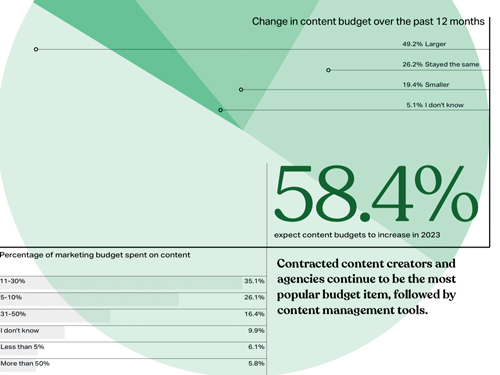 Last year, 42 percent of respondents expected the content marketing budget to increase. Based on results from this year’s survey they did. Despite global economic uncertainty, marketing budgets are expected to increase again next year, proving the essential value of content marketing for organizational success, even in shaky times. For those that expect their budget to decrease, it’s almost solely due to economic factors. As a declining economy raises concerns, the ability to tie ROI to content will only increase in importance over the next year.
Last year, 42 percent of respondents expected the content marketing budget to increase. Based on results from this year’s survey they did. Despite global economic uncertainty, marketing budgets are expected to increase again next year, proving the essential value of content marketing for organizational success, even in shaky times. For those that expect their budget to decrease, it’s almost solely due to economic factors. As a declining economy raises concerns, the ability to tie ROI to content will only increase in importance over the next year.
As the economy and business goals shifted over the past year, the need to drive revenue through content became increasingly important. Despite brand awareness remaining the top purpose for creating content, generating revenue and sales jumped from #5 to #2 in this year’s survey: It’s clear when you have revenue goals tied to content, senior leadership is more likely to understand the value of your content marketing efforts. If you’re struggling to get leadership buy-in, tie your content goals back to revenue to prove value. Additionally, in times of economic recession, customer retention expansion becomes crucial to business success. Only 33 percent of people use content to build loyalty with existing customers so we expect this to increase over the next year, along with a percentage of those who use contact to nurture leads as the number of leads decline.
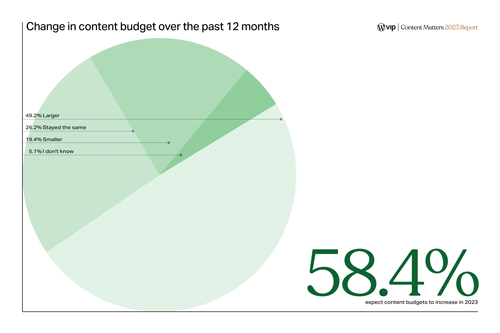 Overall, more content is being created than last year but the percentage of organizations creating more content dropped a bit from 66 percent to 61 percent. Interestingly, 18 percent are producing less content (compared to just 9 percent in 2022), possibly focusing on quality over quantity. Prioritizing content is necessary in a time of limited resources. So how do you decide which content to create? Many organizations are going straight to the source and surveying customers and prospects about what content they want to see.
Overall, more content is being created than last year but the percentage of organizations creating more content dropped a bit from 66 percent to 61 percent. Interestingly, 18 percent are producing less content (compared to just 9 percent in 2022), possibly focusing on quality over quantity. Prioritizing content is necessary in a time of limited resources. So how do you decide which content to create? Many organizations are going straight to the source and surveying customers and prospects about what content they want to see.
As for formats, multimedia content creation has skyrocketed with video and audio, both increasing in importance over the past year. Social media and community building overtook blogs as the most popular type of content marketing. This makes sense with most teams struggling to keep up with demand. Not only is social media often faster and easier to produce, but much of community building is actually user-generated content, requiring fewer internal resources.
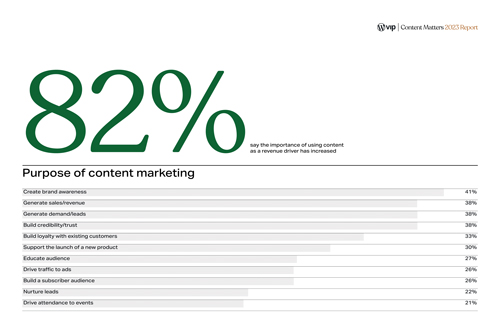 A large part of content strategy involves giving your audience exactly what they want, which is why content personalization is one of the biggest topics in marketing right now. Yet, a quarter of teams still don’t have a strategy in place. Respondents aren’t sure where to start, noting the process is cumbersome. The number of people who want to create more content is drastically lower for those doing personalization. This is likely due to personalization efforts being successful enough to warrant a decreasing content production aligning with the quality versus quantity trend.
A large part of content strategy involves giving your audience exactly what they want, which is why content personalization is one of the biggest topics in marketing right now. Yet, a quarter of teams still don’t have a strategy in place. Respondents aren’t sure where to start, noting the process is cumbersome. The number of people who want to create more content is drastically lower for those doing personalization. This is likely due to personalization efforts being successful enough to warrant a decreasing content production aligning with the quality versus quantity trend.
A strong personalization strategy, and allows organizations to engage with the audience more effectively with less content. There are many emerging personalization and localization technologies to make personalization easier, like SalesForce and Parse.ly. These tools will help your team make smarter, stronger content connections
To create more resonant content, three in four marketers are running tests (like A/B and headline testing). If the goal is to create higher quality content (rather than just producing large quantities), strategies like testing should support this effort.
 Surprisingly, however, the opposite is happening: 54 percent of those testing content actually want to produce more. This leads us to believe the testing is not producing effective enough results to relieve the rise in demand for personalized content.
Surprisingly, however, the opposite is happening: 54 percent of those testing content actually want to produce more. This leads us to believe the testing is not producing effective enough results to relieve the rise in demand for personalized content.
If you’re on the hook to drive revenue with content, you’re also incentivized to measure your progress and impact, so it makes sense most teams that have content marketing revenue goals tend to clearly understand the performance of their content.
The most interesting result to us, however, was that the number of people who measure their content performance and have a clear understanding of how it’s performing jumped to 76 percent — a 25 percent increase over last year.
But as we saw only 46 percent actually use analytics to decide what content to create. It’s no surprise teams lacking in data are also struggling with resources due to the strong positive correlation between content performance and leadership buy-in.
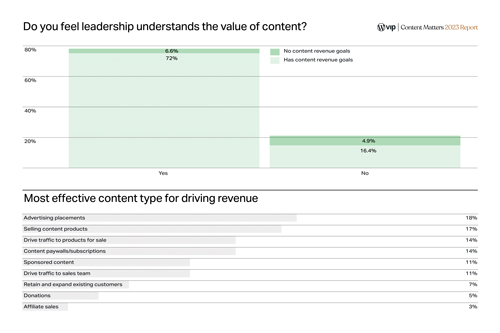 Google Analytics is by far the most used web analytics tool, but we continue to see customers struggle with its complexity, especially non-technical users. With the upcoming shift from Universal Analytics to Google Analytics, the concern is only growing.
Google Analytics is by far the most used web analytics tool, but we continue to see customers struggle with its complexity, especially non-technical users. With the upcoming shift from Universal Analytics to Google Analytics, the concern is only growing.
Twenty-four percent of those who measure their content still don’t have a clear picture of performance, likely due to the complexity of the popular analytics tools. While many customers use Parse.ly and Google Analytics in tandem, they prefer the user-friendliness of Parse.ly for making critical content analytics available to everyone with a stake in content performance.
The future of content is bright, but data will be the spark. More people are still creating more content, but the focus is on quality over quantity due to unyielding demand. Understanding content performance is key to proving its value to leadership and therefore, increasing resources.
Our advice for contact marketers is as follows: most leadership now understands how valuable content is. Capitalize on this by asking for more resources to support your strategy
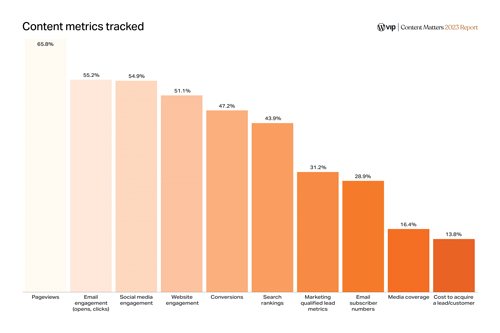 Fast and easy content is becoming more important. Prioritize valuable content and channels that drive traffic, like social media, and user-generated content communities Get more people making data-driven content decisions. If you’ve been relying on someone else to report on your content performance, start getting involved yourself. The need for more revenue means more people will be incentivized to track the impact of their work.
Fast and easy content is becoming more important. Prioritize valuable content and channels that drive traffic, like social media, and user-generated content communities Get more people making data-driven content decisions. If you’ve been relying on someone else to report on your content performance, start getting involved yourself. The need for more revenue means more people will be incentivized to track the impact of their work.
Technical marketers should expect more demand for content publishing methods on owned channels, including video, interactive website content, and potential traffic spikes. Encourage stakeholders to start looking at the data themselves, not sit passively, waiting for you to share content performance reports. Invest in strong personalization technologies and strategies. Your existing CMS and/or analytics tools may already have these capabilities on board.
Excerpted from WordPress VIP’s Content Matters 2023 Report.




